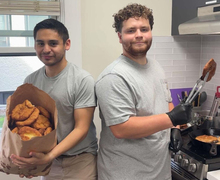Committee measures need for on-campus women’s center
When Syracuse University became the first co-ed university in the state of New York in 1870, its 62 female students had a 10 p.m. curfew. A passage in the student handbook read, ‘You must never let a door close in the face of a woman.’ The school was speaking literally.
Now, 138 years later, many doors have opened for women on campus. A women’s studies program was created in 1989 and the R.A.P.E. center followed in 1990. At the last University Senate Meeting Oct. 8, the Committee on Women’s Concerns reported on its progress establishing a women’s center.
‘If you look across the models of universities across the nation and in Canada, there’s often a center or an office for (female) students, so why not here?’ asked Diane Murphy, dean of the College of Human Ecology and former 10-year chair of the Women’s Concerns committee.
Murphy founded the University Senate Committee on Women’s Concerns, helped create the women’s studies major and drafted the 2004 proposal for a center, which sparked this year’s committee work.
The committee thought there should be a place for women and men to congregate and address issues surrounding gender equity, isolation and sexual assault and harassment, said committee co-chair Martha Hanson. The committee surveyed faculty last spring to find whether the center would be valuable to the campus, and the next step is surveying students in the spring, Hanson said.
While the center is still in the beginning stages, for Murphy, it’s another example of the progress the school has made in the last 10 years.
‘Everything has changed,’ she said. ‘As you look at the university, it might look as if it’s always been like this, but for us who’ve been here for 30 years, this is brand new.’
Chancellor Nancy Cantor was appointed the first female SU chancellor five years ago. Five of SU’s 10 undergraduate colleges are headed by female deans. And women made up 34 percent of the university’s full-time faculty in 2005, six percentage points higher than the national average.
When Murphy attended SU as a graduate student in the mid-70s, there were much fewer female faculty members. With no daycare center on campus, Murphy brought her twin daughters to class and let them play underneath her desk.
‘It was against all odds that you did this,’ she said. ‘What was being said to us at that point was, ‘Go home and take care of your kids. What are you bringing your kid here for?’ But what you had in response was women gathering to say, ‘No, we have a right to be here, and we want to do it all.”
The first wave of women’s centers began during Murphy’s time as a student. As the feminist movement grew, campuses across the nation started asking for, or demanding, centers.
This was the case after a series of rapes on the University of Pennsylvania campus in 1973. Female faculty, administrators and students staged a sit-in and held the president hostage in his office for a weekend. They went to the bathroom in trashcans so they wouldn’t have to leave the office. Discussion on how to create a center began almost immediately following the sit-in, and UPenn’s center opened in October 1973.
The second wave of centers came in the 1990s, when University of North Carolina started the Carolina Women’s Center.
‘North Carolina has been a majority female school since 1973,’ said Donna Bickford, Carolina’s women’s center director. ‘Recently, we approached a 60-40 split, and there was this public hysteria over whether or not we even needed a women’s center anymore. People on the outside just don’t understand what we do, how important it is.’
Bickford said she sees women’s centers as safe places for students.
‘Sexual assault or harassment become very underreported issues if there aren’t specific places doing advocacy and education where people can talk and get information,’ she said.
Nisha Gupta, a professor of women’s studies at SU, said she sees a disparity between the support faculty can provide female students in a classroom and the support that a center could provide.
‘We have a really strong women’s studies program, so people tend to think we don’t need a women’s center,’ she said. ‘But it’s really different to talk about these issues in a classroom setting and to have a place where women can go to explore questions and understand their gender identity together, across generations, without worrying about grades or credit.’
Gupta said she thinks the center would have a unifying effect. She mentioned Resident Adviser programs, the R.A.P.E. center, Students Advancing Sexual Safety and Empowerment, Pan Hellenic initiatives and other groups on campus as strong outreach programs that could benefit from a single center.
‘A women’s center provides something that can tie all of these places together,’ she said. ‘Women’s studies can’t do all of that, and doesn’t.’
Melissa Bennett, a senior in the College of Arts and Sciences and president of SASSE, agreed.
‘I had someone come up to me at an involvement fair and ask about other women’s groups on campus, and I honestly didn’t know whether there were or weren’t any,’ she said. ‘A center would help with that. We’d be less fragmented, better recognized and better supported on the whole.’
Published on October 20, 2008 at 12:00 pm





